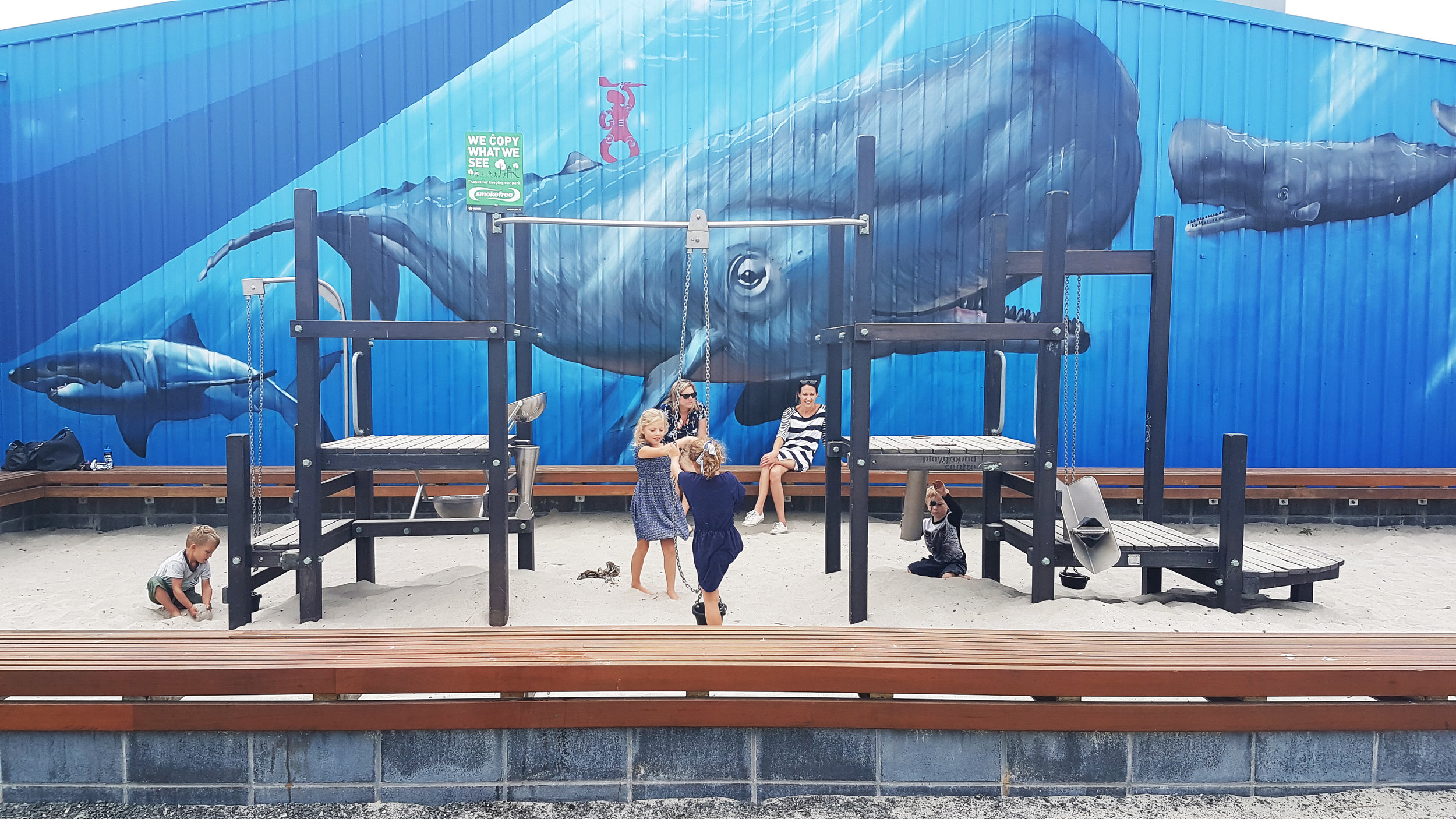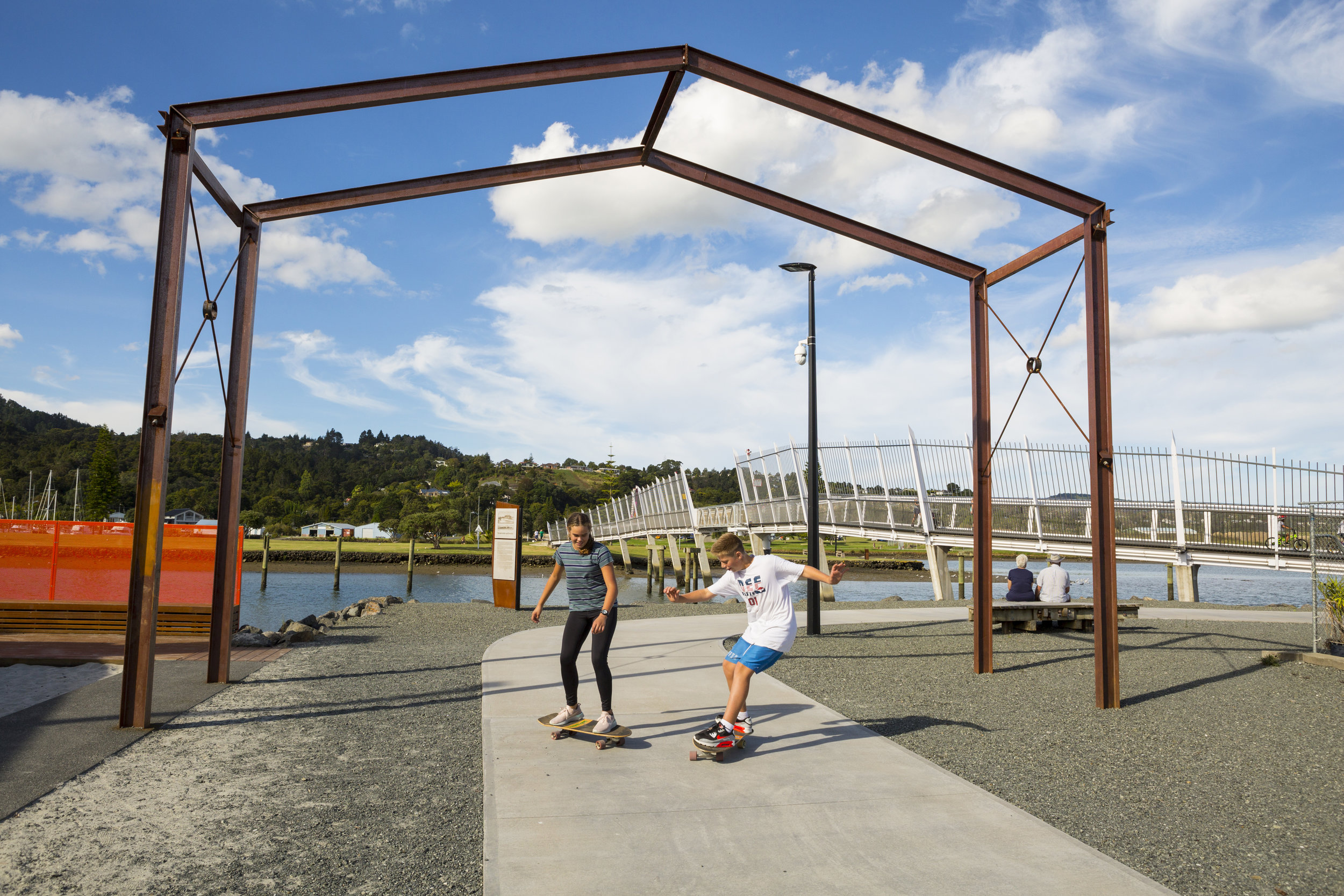Pocket park celebrates Whangarei's waterfront history
Whangarei’s Pocket Park in the central city provides an art-filled, playful space connecting the Okara Shopping Centre to the Hatea Loop - a popular four kilometre pedestrian and cycle path.
While the loop itself - opened in 2014 - exceeded expectations in terms of high user numbers community feedback highlighted a need for more places to sit, enhanced landscaping and shade, activities for children and public art.
A popular space to relax, play & commute on the waterfront. Photo credit Doug Pearson.
In response Whangarei District Council bought the narrow, linear site sandwiched between a car sales yard and a panel beater. Situated on the bank of the Waiarohia Stream with a street frontage onto the main arterial route of Port Road, the 1000m2 site provides a vital pedestrian link between the Hatea Loop Huarahi o te Whai (Pathway of Opportunity) shared path and Okara shopping centre. With sand play equipment and bespoke timber seating it has now become a destination, activating a previously ignored section of the Hatea Loop.
The park offers an unexpected refuge within the commercial and industrial core, inviting visitors to sit, eat, play and socialise while the connector path is popular with recreational and active commuters passing through.
Mural by Charles and Janine Williams, and Mike Tupaea. Photo credit: Tracey Moore
Whangarei’s waterfront is historically and culturally significant as a site of early occupation by both Maori and European settlers. The design aims to enhance and celebrate rich cultural narratives and the site’s former history within the marine industry.
An old boat building, slipway and associated infrastructure were assessed for reuse. Although testing showed the timber was too hazardous, a seven metre tall steel structure used to haul boats onto the hardstand was seen as an opportunity to preserve some of that marine history. The structure was reinforced, becoming an impressive gateway onto the Hatea Loop.
The gateway into Hatea Loop. Photo credit: Doug Pearson
Sections of old pontoons were also reused as seating. And the large sand play area was created by retaining the slipway to prevent flooding on to Port Rd during heavy rain events and storm surges.
Local hapu Te Parawhau, supported the park concept and expressed interest in creatively sharing their stories with large scale murals facing into the park. With the support of neighbouring building owners, the idea was further developed.
Local carver Mike Tupaea and Auckland based artists Charles and Janine Williams were approached to create the public art. All were selected based on their previous work in Whangarei.
A hui between Dr Benjamin Pittman, hapu representative, and the artists was facilitated to enable the sharing and interpretation of cultural narratives and to produce conceptual ideas.
Subtropical plant species soften an industrial material palette. Photo credit: Tracey Moore
Over several weeks stories and experiences were shared and explored before final concepts were agreed upon. The collaboration set a precedent for hapu engagement on future projects, fostered trust and established a positive relationship between Council and hapu.
The result is a vibrant set of murals, overlaid with carved patiki panels featuring kowhaiwhai patterns that represent hammerhead sharks (perseverance and resilience) and fires that illuminate the night sky for a safe passage home (navigation).
The park connects the Hatea Loop with Okara shopping precinct. Photo credit: Doug Pearson
Carved waka and figures representing ancestors combine to tell the iconic stories specific to Whangarei.
A combination of painting and carving, the murals are a symbol of acknowledgement and pride of the rich history that is important to Te Parawhau and allied mana whenua of the wider area.
The space will provide once more a place to gather, a place to eat, a place to rest and a place to reflect – just as it did hundreds of years ago.




